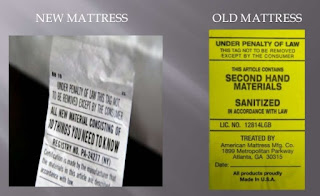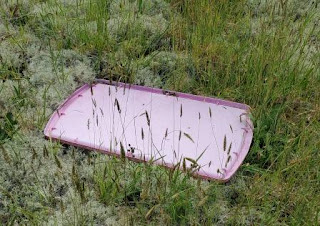- toilet paper
- human waste (either end)
- pet waste unless your cat can squat on the toilet seat and go directly into the toilet bowl...
- diapers
- "flushable" wipes
- baby wipes
- syringes
- expired medication
- tampons - fun fact - plumbers call them "sewer mice"...
- tampon applicators
- feminine hygiene pads
- condoms
- paper towel
- cosmetic wipes
- dental floss
- contact lenses
- cotton swabs a.k.a. q-tips
- cotton balls
- facial tissue a.k.a. kleenex
- razors
- teddy bears and/or toy cars
- cigarette butts
- hair
- food - no matter how soft it is...
- chewing gum
- dead animals (e.g. goldfish, gerbils, etc)
- bleach
- band-aids
- paint
- masks
- gloves
 |
| Not my pic- just some fluffy sewer mice (tampons) hauled out pipes |
Why not? Ohhh... sooo many reasons. Let me tell you about the time in Calgary when one of the toilets in our condo backed up. We had to call in a plumber which is not cheap. He removed the toilet and put a big long snake thing down the line and then started hauling all sorts of interesting things back up. Like sewer mice... a.k.a. used tampons.
We got quite a lecture from him about tampons being most definitely not flushable. Oh sure... technically they are flushable... I mean, you can drop them in the toilet bowl and push the lever and swoooshhhh... they disappear. But... they don't always go very far. Tampons should never, ever be flushed down a toilet. Unless you want an expensive male plumber with low-riding pants to give you a lecture on tampons while fishing your used ones out of your sewer stack. Your choice...
Now... it's not just tampons that can be fished out of your clogged sewer line... any one of the things on that list (other than human waste and toilet paper) could cause a clog in the pipes. Toilet paper is designed to decompose quickly once it's flushed away. Other paper products, like tissues and paper towel, while they might look dissolvable... are not.
But... we're not done yet. Because what goes down the other drains in your house also plays a role in the condition of your pipes.
 |
| Also not my pic... the sink I had to deal with was worse |
Knowing how expensive plumbers are (see story above)... I grabbed a plunger and a few other tools and trotted over.
They had a double sink... both sides of which were completely, utterly full of greasy water. I did a bit of research and learned that if you want to use the plunger on a double sink, you need to make sure the drain plug is in place in the other sink. Which meant I had to roll up my sleeves and stick my arm into a disgusting greasy morass... but I did it. And then plunged the other sink and... swoosh... it eventually all went away. From one sink. I had to then pull the plug on the other sink and it too cleared.
I then had a bit of a conversation with our tenants about what should
and should not be poured down a sink drain. Grease/fat/oil is a definite
no-no. I told him that we pour ours into either empty glass jars (like a
pickle jar) and/or empty milk cartons. We don't just pour off excess
grease from the frying pan... we then wipe it with a paper towel and add
that to the green bin container (our municipal green bin takes any
food/cooking waste).
And then... of course... we have the bathroom sink and tub drains. Here's a few tips... If you are one of those people who does coconut oil pulling (rinse your mouth with coconut oil), please, please, do not spit that stuff down the bathroom sink. It clogs the pipes up horribly.
Also... don't trim your hair over the sink... hair takes forever to decay (like decades... maybe centuries). Use one of those mesh traps for your bathroom sink and/or tub drains.
 |
| Pipe partially clogged with grease |
All of this is a prelude to the real story... fatbergs. Have you heard of them? They are seriously gross.
Imagine a 250 metre long mass of hardened, congealed fat/oil/grease mushed together with condoms, diapers, "flushable" wipes, tampons, syringes, etc... in the sewer lines of London. Weighing it at 130 tonnes... stinking like "rotting meat mixed with the odour of a smelly toilet". Having to be chipped and chiseled and shoveled out by city workers dressed in hazmat suits over the course of nine weeks. That was the Whitechapel Fatberg of 2017.
 |
| Whitechapel Fatberg - 2017 |
FOGs (fat/oil/grease) don't just clog the pipes of our houses... they clog the pipes under our city streets. And they are extremely expensive to clean out. Not only that... they lead to sewage backups which are messy, expensive and very damaging to the environment. Think raw sewage (all that lovely human waste combined with toxic bacteria like E. coli and Listeria) backing up into your basement, flowing down the street into streams and seeping into the groundwater.
Now... it's not just household grease that's the issue... fast food restaurants produce an inordinate amount of cooking grease and the biggest fatbergs are, not surprisingly, found near areas rich with fast-food places. There are grease traps which can help to capture most of the cooking grease from these restaurants but they also need to be maintained and cleaned regularly... which doesn't always happen.
All of this means that cities spend millions of dollars every year cleaning up clogged pipes and sewer lines of fatbergs, not to mention sewage overflows. Which gets pushed back to the taxpayer... you and me. So... why not help prevent fatbergs in our sewers... and protect your own household drain pipes, by not tossing/pouring/spitting/dropping into your sinks/bathtubs/showers/toilets...
 |
| The Flushable Trinity... |
P.S. During the creation of this blog, a household conversation ensued about vomit. Does it belong in the toilet or not? Is it "flushable"? In a good way? The answer seems to be "yes". I couldn't find it on any "unflushables" list... so readers are free to commune with their porcelain bowl whenever the need arises.
For those interested... there's a short little video put out by Metro Vancouver that has a humourous look at fatbergs...
The Guardian - Fighting Fatbergs: This is now a Huge Environmental Issue", 2019































